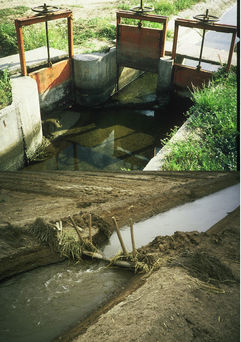Irrigation Systems
Irrigation is the basis for human civilization. The value human societies place on water – for food, domestic use, economic production, and spirituality – has led all civilizations to manipulate water flows. Food security through irrigated agriculture enabled development of urban kingdoms in many regions: Mesopotamia, Egypt, the Indus-valley, China, Mexico and Peru. Intensified production provided a relatively secure food source for a larger population as it enabled the peasant population to produce a surplus to support the non-peasant population. For European colonial powers irrigation was an important instrument as well.


Irrigation is shaped through complex interactions between the domains of Hydrology, Hydraulics and Humans. The natural environment – hydrology – sets boundary conditions for humans, to which humans respond with irrigation technology – hydraulics – with such responses impacting both boundary conditions and humans anew. Irrigation combines both top-down – physical – processes and small-scale direct interactions between humans, extra interactions to be included in analysis are complex and emergent properties are many. How human (inter)actions shape irrigation infrastructure operation is a major field of study. It is hard to ignore the calls for socio-technical – interdisciplinary, holistic, integrated – approaches to understand irrigation.

However, technical aspects – like hydraulic flexibility, system response, travel time – are needed to understand social – mainly organizational – problems in irrigation. Although such ‘pure’ hydraulic work alone will not be enough to understand daily practices in irrigation, it cannot be stressed enough that hydraulics matter. Irrigation infrastructure shapes a certain reality of water flows in space and time. Human actors do help infrastructure in shaping hydraulic reality, for example by setting gates or damage canals. Furthermore, actors give value to hydraulic reality; whether non-uniform behaviour is a problem is not determined by hydraulics itself. Typically, hydraulic infrastructure connects human agencies within different spatial and temporal settings.
Do you want to know more? Check the project pages or contact Maurits Ertsen.
Related projects
- Modeling human agency in irrigation
- Modeling irrigation in the ancient Americas
- Field work in irrigation systems
- Irrigation in colonial and post-colonial Africa
- Irrigation in the Netherlands East Indies
- Irrigation in the Netherlands
WRM Issues | Related Tools |
Legal and policy analysis | |